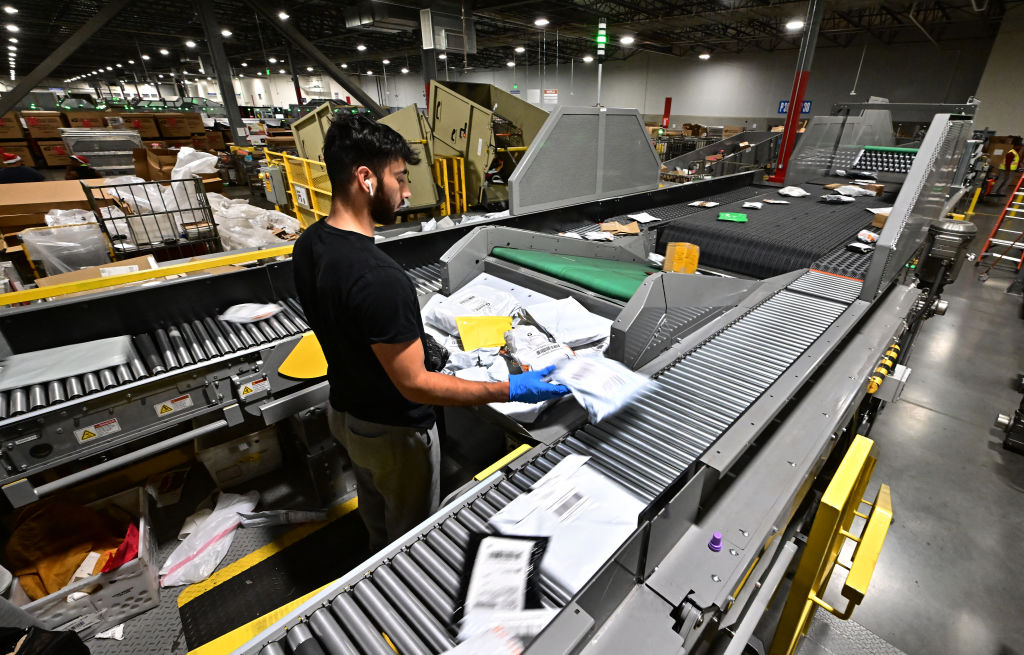With the U.S. Postal Service tasked with ensuring all mail-in ballots are received by local election officials on or before Election Day, the federal mail delivery agency introduced “extraordinary measures” on October 21 to expedite ballot delivery—as it does each election year. However, a social media user has falsely claimed that those extraordinary measures compromise election integrity and accused USPS of being complicit in voter fraud. USPS denied these claims to The Dispatch Fact Check.
Peter Bernegger, who filed more than a dozen lawsuits challenging the results of the 2020 election—all of which were dismissed—and in 2022 was fined $2,400 by the Wisconsin Elections Commission for filing frivolous complaints, tweeted Monday: “US Postal Service DOING IT AGAIN! Changing the mail delivery method of absentee ballots coming into election clerks.”
Bernegger referenced a prior tweet he posted on October 27, which he described as a “bombshell. “They are hiding the evidence of absentee mail-in ballot fraud—by not allowing the evidence to be created in the first place,” he alleged. Bernegger continued, claiming that USPS changed how it processes ballots sent via mail. “You can't get the absentee mail-in vote ballot images from the USPS because they are not sending them to the central sorting facilities!” he said. “The UPSP recently directed, less than a month, post offices to NOT send absentee mail-in ballots to central sort. But instead take them to the election clerks. Meaning again: no electronic ballot images are being created in the first place. The USPS is doing this on purpose.”
While U.S. mail that passes through larger facilities goes through sorting machines that take images of the pieces, the change is not evidence of voter fraud—it is standard USPS procedure. USPS senior public relations representative Marti Johnson explained that the recent change to USPS ballot processing Bernegger referenced is part of what the mail delivery service calls “extraordinary measures designed to accelerate the delivery of ballots mailed close to election day.”
Those changes were made in this election cycle, “Just as we have done in past general elections,” Johnson told The Dispatch Fact Check. “Those extraordinary measures began nationwide on October 21 and include additional collections, extra deliveries, special sort plans on processing equipment, and local handling, including postmarking and transportation of ballots.”
So while Bernegger is correct that, after October 21, ballots are no longer sent to large centralized mail processing facilities, he is wrong that that is evidence of voter fraud—the purpose is to expedite ballot delivery. “For example, under normal operations, any piece of mail, including an absentee ballot, is handled and postmarked at the processing facility closest to its originating post office and, depending on how far it is going, will be handled again at one or more processing facilities closer to its destinating post office,” Johnson explained. “Starting on October 21, return ballots that are destined to a local or nearby election office will bypass the processing operation and will instead be postmarked at the local unit and delivered to the election office.”
Regardless of whether USPS extraordinary measures have been deployed, the U.S. Postal Inspection Service—a federal law enforcement agency arm of USPS—physically observes how ballots are processed and delivered “throughout the election.” As Johnson explained, “They will review the physical security of election mail as well as the physical security of processing and delivery locations and report their findings to Inspection Service and Postal Service leadership so that corrective action may be taken for any concerns that are identified.” She added that all postal inspectors have “specialized training and equipment” to ensure the integrity of all absentee mail-in ballots handled.
The Dispatch Fact Check has reached out to the Postal Inspection Service for clarification on whether its ballot security operations take scanned photos of ballots processed in the mail.
If you have a claim you would like to see us fact check, please send us an email at factcheck@thedispatch.com. If you would like to suggest a correction to this piece or any other Dispatch article, please email corrections@thedispatch.com.







Please note that we at The Dispatch hold ourselves, our work, and our commenters to a higher standard than other places on the internet. We welcome comments that foster genuine debate or discussion—including comments critical of us or our work—but responses that include ad hominem attacks on fellow Dispatch members or are intended to stoke fear and anger may be moderated.
With your membership, you only have the ability to comment on The Morning Dispatch articles. Consider upgrading to join the conversation everywhere.